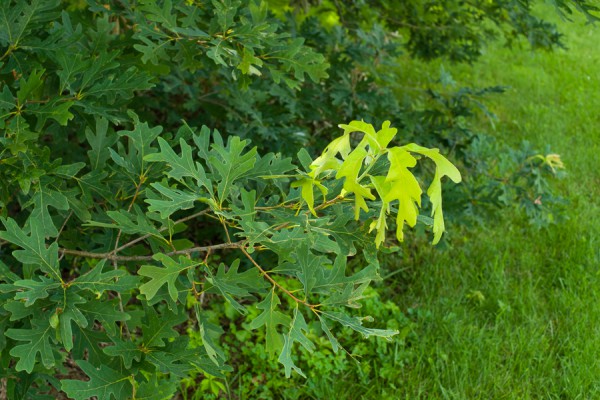
Second flush of growth in the wet growing seasong of 2013. Bur oak. Click for a gallery of late season shoot growth
Trees are generally very conservative in their growth habits. They often go to extremes to avoid rare events such as an early frost or severe drought. This is especially true of shoot growth. Although we think of trees as growing all summer, most trees only grow in height for a few weeks. Flowering dogwood sets a bud and quits growing in May or June, and so do most maples and oaks. In 2013 and 2014, conditions were good enough for many trees to pause for a while and then produce a second flush of growth. Click on the photograph for a gallery of trees with late-season flushes of growth.

Late season shoot growth in yellow-poplar. Click for a gallery of late season shoot growth in yellow-poplar.
Fast-growing trees like yellow-poplar, Liriodendron tulipifera, have a different pattern, one that is much riskier but allows for faster growth. In the spring, yellow-poplar produces a flush of growth from the bud, just like other trees but then, instead of setting a new bud and pausing, yellow-poplar continues to crank out new leaves without a bud. This is a fast-growth strategy, one taken by the majority of fast-growing trees. This year, yellow-poplar leaves are beginning to turn color as the days get shorter, but the trees just won’t quite making new leaves. This may have to do with the unusual buds of yellow-poplar – each leaf is encased in a clam-shell arrangements of bud scales (actually stipules) so that even if a newly-developing leaf is exposed to cold, the next leaf is protected. Look carefully at yellow-poplars, cottonwoods and other fast-growing trees and see if they are still growing. Click on the photograph for a gallery of yellow-poplars with continuous growth.
Although we might expect trees in tropical moist forests to have the same continuous growth pattern as yellow-poplar, the vast majority, in my experience, have recurrent flushes of growth with a pause in between This may be a strategy to avoid having young, tender leaves constantly available for hungry predators.